This is a guest post by Yussif Abuharaz, an undergraduate student at Michigan State University.
I come from a thriving Muslim community in Flint, Michigan, made up of more than 100 families from many different cultural and ethnic backgrounds. My dad is originally from Omdurman, Sudan, and my mom is from Manchester, England, so both grew up in cities passionate for their football (soccer)!
Most kids in our community receive their education at The Flint Islamic Center and its community has served as my ‘home’ since I was born. Our community has a wealth of football talent and this was seen early on by Talal Khoulani. Talal, who was born in Germany and moved to America as a baby, is of Syrian descent. In 1999, Talal founded FOB soccer, which got its name from the tongue-in-cheek expression “Fresh off the Boat”. It started off as a small team that took part in the local six-a-side indoor league. It quickly grew into a recognizable and established football “mini” club that has fostered some phenomenal players. FOB is widely recognized in Flint’s Genesee County and has a reputation as a respectable organization in the Michigan soccer community.
As a Flint-born Sudanese-American, my life has revolved around football and for this I am very grateful to FOB. It has provided me with countless opportunities and experiences that I will always value. FOB has brought together our community of recent immigrants and established Michiganders. I have made good friendships and enjoyed playing with some amazing players and lots of people from different backgrounds.
Although little known outside our small Flint community, FOB has produced some fantastic players that have gone on to play NCAA soccer at Division 1 and 2 level and one of us just signed a professional contract in the MLS/USL. The centerpieces of FOB are a highly competitive men’s league and one of the biggest and most prestigious 3v3 holiday tournaments in the region: the FOB Turkey Shootout. Those of us in the community look forward to this event all year: it’s always one of the best times of the year. The teams are a mix of semi-pro, D1/D2 college athletes, and some very talented young players.
FOB is a fine example of the kind of grassroots soccer that exists in the U.S. but rarely gets media coverage. In an attempt to draw attention to the accomplishments of the program, here is a list of the Top Ten players to ever wear the FOB jersey.
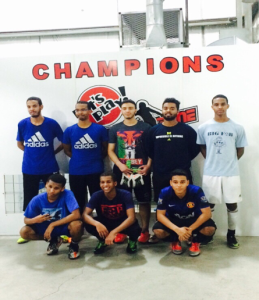 1. Issa Rayyan
1. Issa Rayyan
Rayyan is a Jordanian-American born in Dearborn, Michigan, and is probabably a clear-cut number 1 choice. He recently signed his first professional contract with Bethlehem Steel, Philadelphia Union’s USL team, after completing a year at Duke University and playing for Union’s academy team for several years. A lightning-quick player of exceptional technical ability and a very high soccer IQ, Rayyan has been involved with FOB Soccer from a very young age. He regularly participates in FOB Men’s league and the famous Thanksgiving Turkey Shootout tournament, putting in some of the most memorable performances to go along with a Men’s league championship and a Turkey shootout finals appearance.
2. Yamann Sahlool
An American-born Syrian, Sahlool grew up with FOB and has contributed significantly to its growth. Receiving high-level training and playing on two Michigan academy teams in his teenage years, Sahlool developed into a rising prodigy. A combination of terrific finishing skills, strong on-the-ball ability, and sensational off-the-ball awareness led to him scoring bunches of goals and having dominant performances etched in FOB history. Ruthless in front of goal, Sahlool won a Turkey shootout championship and went on to play at the University of Michigan for four years.
3. Khaled Zaki
Born in Egypt, Zaki is one of FOB’s most exciting players. He has showcased some of the best performances in both the Turkey Shootout and the men’s league. Grace on the ball and quick feet are at the root of his exceptional skills that make him one of the toughest players to contain. Zaki is a multiple-time leading goal scorer in the men’s league, multiple-time All-FOB first team, winner of the best offensive player award, and a Turkey Shootout champion. Yet another player who personifies what FOB is all about.
4. Belal Khoulani
Khoulani’s older brother started FOB and he is been part of the program since he started playing. A Syrian-American born in Arkansas and raised in Flint, he is an extremely well-balanced all-around player with an outstanding work rate and soccer IQ, Khoulani can play in a number of different positions: he makes great runs in defense, leads the attack, and truly shines in the midfield. Having the ability to affect the game in several ways is Khoulani’s unique trait. He controls the pace and tempo of the match while staying tactically disciplined in whatever position he’s in. Khoulani currently plays Division 1 soccer at the University of Wisconsin-Green Bay, after several years at the Vardar academy. He is a three-time men’s league Champion and assist leader, Turkey Shootout champion, and first team All-FOB.
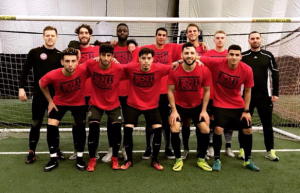 5. Ali Mukhtar
5. Ali Mukhtar
Mukhtar is regarded as one of the most exciting players to ever come through FOB. He is a Sudanese-American born in Flint, raised in Mississippi, who then moved back to Flint in middle school. A dazzling footballer who can use both feet equally well and has the ability to make any defender look silly. An extremely smooth and graceful player, he combines devastating pace and quickness with solid strength on the ball. Mukhtar is also a clinical finisher. He has played FOB since elementary school. Mukhtar is a three-time men’s league champion and leading scorer, Turkey Shootout champion, First Team All-FOB, and a four-time league MVP.
6. Kareem Shukairy
Shukairy is a Syrian-American raised in Flint. The Shukairy family is one of the biggest families in the local Muslim community which FOB anchors. A “Rolls Royce”-style player, Shukairy is smooth, poised, and elegant on the ball. A highly intelligent player who seems to always have his way on the field, he possesses high quality shooting and dribbling technique and is one of the smartest players on the field. Shukairy is a regular in Turkey Shootouts, men’s league, and college league. He is a Turkey Shootout champion and two-time First Team All-FOB.
7. Mohammad Mohammad
An Iraqi-American, Mohammad is an electric player with great pace. A versatile player who can play in the back line and on the wings, it is clear to see why he is so highly valued. Mohammad has been a part of FOB for many years and is regarded as one of the original FOB players. He is a men’s league champion and Second Team All-FOB.
8. Omer Saeed
A gifted and intelligent player, Saeed is seen as probably one of FOB’s most influential players. He is one of the many who were born and raised in Flint with a Sudanese background. He has the ability to completely dominate a game from the middle of the park and can be a match winner on any given day. Saeed is one of the smartest and most technically gifted midfielders, skipping past opponents with ease and picking out the perfect pass better than anyone. Saeed regularly tops the assist charts and continuously makes big plays. He is a two-time men’s league champion, All-FOB First team, four-time men’s league assist leader, and a men’s league MVP.
9. Yussif Abuharaz
According to Talal Khoulani, Abuharaz is the sort of the player that may go under the radar, but is a jack-of-all trades. He can put in solid shifts in defense, midfield, and attack. He placed in and around the top 5 in goals and assists almost every season. Abuharaz is exceptionally technical and a very good passer of the ball. His understanding of the game is up there with the best and he is willing to do all the dirty work in the midfield to help his team. His smooth, yet gritty style of play can be both easy on the eye and highly effective. Abuharaz has played for FOB since he was in middle school and is a two-time men’s league champion and a Turkey Shootout champion.
10. Sammy Saeed
Younger brother of Omer Saeed, Sammy is also a Sudanese-American from Flint. A speedy player of extraordinary fitness and athleticism, Saeed can be an effective and versatile player. At his best as a winger, he can also step in to play in the back line and make an impact on the game even as a forward. Saeed is regarded as a work horse who covers plenty of ground. He defends exceptionally well while being a box-to-box threat who can pop up with goals and assists. Saeed is also technically gifted and capable of breezing passed any defender who stands in his way. He is a two-time men’s league champion and two-time Turkey shootout runner up.
* * *
Soccer in the United States is growing rapidly. Despite its popularity, there are still major improvements needed. I believe more emphasis should be placed on individual player development and changing recruitment patterns. Small organizations and clubs can play a key role as they implement grassroots football values and styles that are critical for the game. FOB has done so for me and the Flint immigrant community that I have been lucky enough to call my own. Not only has FOB crafted me and many others into quality footballers that absolutely love the game, it has also served as a means of bringing people from many different cultures and ethnicities into one big family that, still to this day, take to the pitch as brothers above all else.
Tag: youth
The Apartheid Football Syndrome
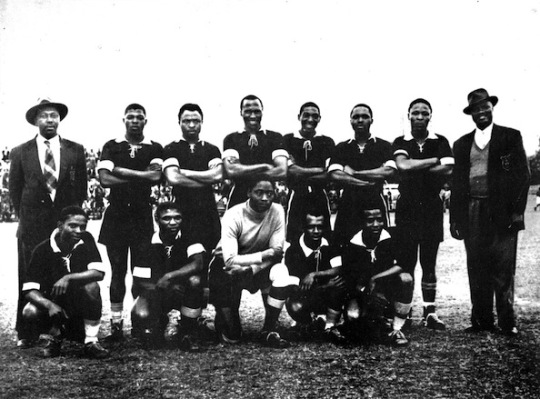
Photo: Durban & District African FA select team, Rhodes Centenary tournament, Salisbury, Rhodesia (1953)
Football is Coming Home is pleased to receive and publish a guest essay by Zipho Dlangalala, a South African fútbologist who has coached players and trained coaches for many years at all levels. He is a teacher by profession. It has been lightly edited for style.
Guest Post by Zipho Dlangalala (makhandaz@hotmail.com)
KWAZULU-NATAL—All sports are played in, and influenced by, past and present social conditions. This is largely, if not entirely, because sport is played by people who are social beings.
When we see most of our South African players playing the same way, looking like identical midfielders, we should know instantly that we are looking at them with “foreign eyes.” They will always look like that as long as we evaluate them with foreign tools and criteria.
To African eyes, it is those midfield players that should reveal the nature and inclination of our players. Their creativity and desire to care for the ball—the uninhibited attraction to artistic modes of play—are great assets that we should have treasured so that their game exhibits the same attributes found in them naturally, at least before being diluted.
Regrettably, the Apartheid philosophy and its legacy was too strong for most of us. Based on seeing life through Master-Slave, Boss-Subordinate, Superior-Inferior, Rich-Poor, Educated-Illiterate, Advanced-Primitive, civilized-uncivilized relationships, this “baaskap” paradigm has engulfed us. Even when we know it is not desirable, we often find ourselves promoting it, advocating on its behalf through actions more than words.
It makes us feel acceptable and progressive to be seen as “the master.” We do everything and anything to feel accepted and to get approval from those who represent “the master” perspective. It has been engraved in us to look for this approval, otherwise we feel we do not have the capacity to stand by ourselves and achieve success on our own. The desire to be associated with, to be affiliated to, approved by, “the master” is hard to resist for most. It is this prevailing mentality in South Africa that undermined indigenous cultures, languages, restricted people’s movement and freedom to associate, to think, to explore, to design, to invent, to discover.
It is a “total control” approach of life. It attempts to control what people think and learn. Given the slightest opportunity, it dictates LIFE to each and every person who is supposed to be subordinated (and limited) to its wishes and desires.
In a cultural and socio-economic environment shaped by a social hierarchy long based on race, fertile ground exists for past tendencies to endure. The more things change, the more they stay the same.
Football under these conditions cannot be sustained, let alone developed.
Looking at football through a particular lens inevitably results in the game looking in a particular manner. Are we using proper African perspectives to look at the game as it is in Africa? Are our views coloured to give us a special feeling? Are we ready to bring something new to world football or are we content to follow established paths and continue to consume what is already in the market? We are entrepreneurs and have skills. We need to develop them and show our own ideas to the world. We need to create something new in our football for the world to sit up and take note.
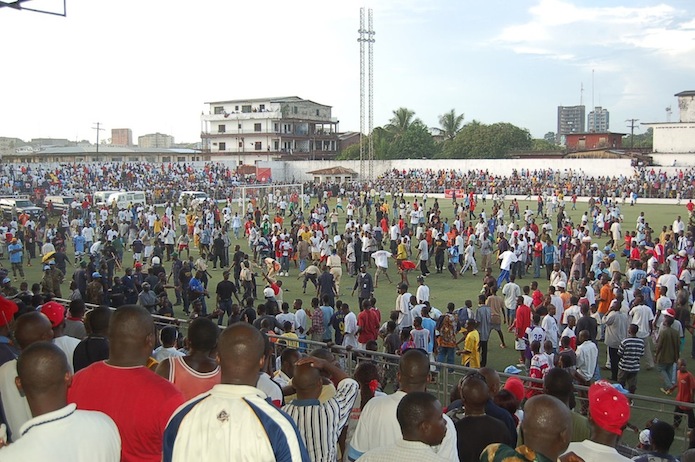
Football is Coming Home is pleased to welcome Pelle Kvalsund for a new series on the field of sport development. How can we develop regular long-term sport opportunities for a youth population that is predicted to double in the next thirty years? How do we ensure that the services produced for these athletes are of quality and value so that we can retain both athletes and coaches? This first post outlines some of the main institutional and economic challenges.
By Pelle Kvalsund
Pelle Kvalsund, international sport development consultant, is a former athlete, coach, and physical education teacher from Norway. As a consultant for over 15 years, he has worked in many countries including Vietnam, Sri Lanka, Burundi, Zambia, and Bosnia. Pelle has served a number of international organizations, both within sport and the area of community development, and is currently an advisor for the Norwegian Olympic and Paralympic Committee and Confederation of Sport and their partners in the global south. He is the author of “Sport as a Response to Emergencies and Disasters” in Sport, Peace and Development, edited by Keith Gilbert and Will Bennett (free download here).
I’m at the National Stadium in Monrovia, Liberia, in 2007, watching a women’s international football match between the host nation and Nigeria. The stadium is jam-packed with fans and UN peacekeepers. It ends 1-1. A fair result from my perspective as a neutral observer, but not for the home fans. A riot breaks out. The crowd storms the pitch and the UN peacekeepers fire teargas to save the unfortunate referee from the mob.
There is a lot to be said about this rowdy incident, but above all else it illustrates the extraordinary popularity of football and the social importance of sport, particularly in sub-Saharan Africa and other parts of the world where resources are scarce and life is generally challenging and unstable.
And it is precisely sport’s cultural significance that provides those of us working in sport development with a foundation on which to build sport programs that offer positive activities and outlets for many children and youth.
Let me start by doing something that I hate doing, but have become quite good at: identifying a stereotype. I do this to present a general image of the field of sport development in the Global South (though it applies to parts of global north too).
Such a country boasts a Ministry of Sport, which is paired with the Ministry of Youth or the Ministry of Education. The department of sport is of very high personal and political interest within government circles due to the widespread popularity of sports in society (particularly football), but the same interest is not reflected in the budget allocations. Most of the sport budget is used to pay the government employees (directly and by extension) and to maintain their status. Some of the money pays for upkeep of facilities and the participation of national teams in international competitions. Most of the remaining funds find their way to the national football association, while only a symbolic sum goes to athletics, basketball, volleyball, and other sports with athletes capable of winning a medal for the country on the global stage.
Administratively, the country has a national sport council or commission (the extension mentioned above) mandated to roll out government policies, distribute government funds, provide logistical support for major competitions, and govern and support the associations. A national Olympic committee bring selected athletes to the Olympic Games every four years. In addition, it has the financial ability to support elite athlete development and organizational capacity building through a central program called Olympic Solidarity.
Each sport also has a national association that generally consists of an “elected” board and president, and a general secretary. The president makes the important decisions and the general secretary does the work. There is no office. The association’s documentary records are tucked away in a briefcase or (if lucky) in the general secretary’s laptop. The associations run their operations according to a calendar of events.
There is no long-term plan, just day-to-day survival. Money is impossibly scarce and there is neither sufficient equipment nor adequate facilities. Instead of a youth development plan, potential athletes are recruited from a few well-endowed schools that host inter-scholastic sport competitions once or twice a year. In the case of football, private academies and sport and development NGOs of varying size and quality also train young boys. (Girls are rarely included in these programs.)
This stereotype of how sport is organized and run in a country of the Global South should help to better understand the stark challenges before us and how they shape the multiple and diverse attempts and approaches used to develop sport in poorer regions of the world. In the blog posts that follow, I intend to share reflections based on my experiences in Africa and beyond to spark a dialogue with readers about the differences between “Sport Development” and “Sport For Development” and why these matter. I look forward to the conversation.
Part 2 of my interview with Boyzzz Khumalo (part 1 is here) opens with a description of the harrowing injury that prematurely ended his Major League Soccer career.
Boyzzz reflects on the inherent fragility of professional sports, the importance of higher education for life after soccer, and his extensive youth coaching experiences in both Soweto and in Michigan.
Boyzzz’s deeply personal commitment to community upliftment comes through in a detailed discussion of the challenges and hopes for the Umhlaba Vision Foundation. Anyone interested in getting involved or learning more about Umhlaba can send email to boyzzzkhumalo80 AT gmail.
Boyzzz Khumalo: From Soweto to Michigan
Thabiso “Boyzzz” Khumalo grew up in Soweto, South Africa, around the corner from the homes of two Nobel Peace laureates: Nelson Mandela and Archbishop Desmond Tutu. Like so many boys in the land of apartheid, he spent every moment of free time playing soccer and dreaming of becoming a professional player overseas. Unlike most of them, however, Boyzzz fulfilled his dream
On July 22, I sat down with Boyzzz for an interview on the campus of Michigan State University. We’d been hoping to do an interview ever since we met in November 2013 when he visited my “Sport in African History” seminar for a screening and discussion of Invictus.
This week was an especially opportune time to chat about Boyzzz’s sporting life because on Sunday, July 27, Lansing United, his current team, travels east to New Jersey to play a National Premier Soccer League semifinal against New York Red Bull Under-23.
How does a young man from Soweto end up playing in Michigan? In part 1 of our interview, Boyzzz shares memories of anarchic pickup games in Soweto; his first experience in the U.S. during a youth tournament that would change his life; and then scoring his first MLS goal for DC United.
Boyzzz also discusses the work of the Umhlaba Vision Foundation–a nonprofit organization he founded in 2007 with two South African friends. The goal of Umhlaba (meaning “world” in the Zulu language) is to change the lives of young Sowetans by creating a positive development environment through sport and education and bringing student-athletes to the United States. For more information about the foundation please email Boyzzz (boyzzzkhumalo80 AT gmail).
Don’t forget to come back tomorrow for part 2 of the interview!
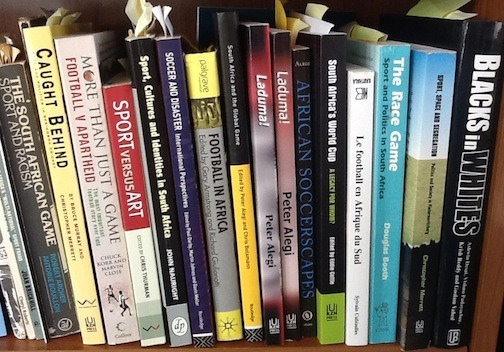
Guest Post by *Marc Fletcher
Gloomy skies and wet weather greeted the Research Forum on South African Football held at the University of Johannesburg (UJ) last month. The bleak conditions made for an intimate crowd, but the academics, journalists and sports practitioners in attendance were rewarded with three strikingly different presentations on varying aspects of the “beautiful game” in South Africa. The aim of the forum was to advance the specialized study of soccer in the country and beyond.
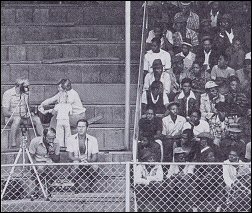 First up was Chris Bolsmann, a South African sociologist based at Aston University, Birmingham. His paper entitled “Professional Football in Apartheid South Africa: Leisure, Consumption and Identity in the National Football League, 1959-1977” provided a rich history of the whites-only National Football League (NFL) during apartheid. The common misconception of South African football is that it has historically been, and continues to be, an exclusively black, working-class game. Yet, Chris’s work challenges such a perception and begins to reconstruct a past that is often forgotten or even ignored. Matches in this white league were staged in front of segregated crowds. A successful corporate affair, the NFL attracted a host of world-renowned players, including George Best and Bobby Charlton. In concluding that the NFL became the leisure and sporting entertainment of choice for significant numbers of white and black (particularly Indian and Coloured) South Africans, this history emphasized how football in South Africa has had a more diverse support base than is often acknowledged.
First up was Chris Bolsmann, a South African sociologist based at Aston University, Birmingham. His paper entitled “Professional Football in Apartheid South Africa: Leisure, Consumption and Identity in the National Football League, 1959-1977” provided a rich history of the whites-only National Football League (NFL) during apartheid. The common misconception of South African football is that it has historically been, and continues to be, an exclusively black, working-class game. Yet, Chris’s work challenges such a perception and begins to reconstruct a past that is often forgotten or even ignored. Matches in this white league were staged in front of segregated crowds. A successful corporate affair, the NFL attracted a host of world-renowned players, including George Best and Bobby Charlton. In concluding that the NFL became the leisure and sporting entertainment of choice for significant numbers of white and black (particularly Indian and Coloured) South Africans, this history emphasized how football in South Africa has had a more diverse support base than is often acknowledged.
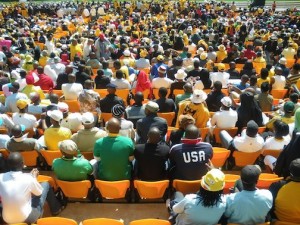 My paper on “Divisions, Difference and Encounters in Johannesburg Soccer Fandom,” explored contemporary cultures of fandom beset by race and class divisions, where domestic football is regularly constructed as an Africanized space without white supporters. However, through an ethnography of Kaizer Chiefs, Bidvest Wits, and Manchester United supporters’ clubs in Johannesburg, I began to explore the deeper complexities, where supporters on the margins of these groups began to engage with the other. In doing so, some fans challenged these social barriers in football and thus reinterpreted their understanding of soccer fandom and their wider experiences of everyday life in the city.
My paper on “Divisions, Difference and Encounters in Johannesburg Soccer Fandom,” explored contemporary cultures of fandom beset by race and class divisions, where domestic football is regularly constructed as an Africanized space without white supporters. However, through an ethnography of Kaizer Chiefs, Bidvest Wits, and Manchester United supporters’ clubs in Johannesburg, I began to explore the deeper complexities, where supporters on the margins of these groups began to engage with the other. In doing so, some fans challenged these social barriers in football and thus reinterpreted their understanding of soccer fandom and their wider experiences of everyday life in the city.
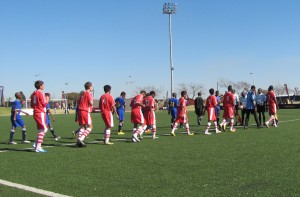 Chris Fortuin, based in the Department of Sport and Movement Studies at UJ, gave the third paper–an eye-opening account of the grim state of youth development in South African football. It was alarming to hear the inadequate ratio of qualified youth coaches to players in South Africa compared to some of the giants of international soccer, especially Spain. The shortage of such coaches, along with the absence of a coherent development plan at the national level, is harming the game at all levels and has contributed to the malaise of the men’s national team, Bafana Bafana.
Chris Fortuin, based in the Department of Sport and Movement Studies at UJ, gave the third paper–an eye-opening account of the grim state of youth development in South African football. It was alarming to hear the inadequate ratio of qualified youth coaches to players in South Africa compared to some of the giants of international soccer, especially Spain. The shortage of such coaches, along with the absence of a coherent development plan at the national level, is harming the game at all levels and has contributed to the malaise of the men’s national team, Bafana Bafana.
The presentations encouraged members of the audience to think more seriously about football as an academic field of inquiry. During the second half of the forum panelists responded to numerous questions from the floor. One question stuck out, one that is often asked; why are black South Africans not writing about this subject? It is true that much of what is written on the subject is by foreigners like me. But a main goal of football scholars, regardless of origin, is to empower South African students in the humanities and social sciences (and other fields) with tools and desire to critically engage with football studies.
With questions on the presentations filling up the second half, the question of where does the academic study of South African football go from here was left unresolved. Events such as the UJ forum can play a vital role in motivating South African scholars to research and write about their game. Clearly, football is a legitimate and fascinating area of research. But many more events like the forum are needed to further develop the field and chart future directions.
To this end, readers of this blog who are in the Johannesburg area, are welcome to attend the UJ Wednesday Seminar Series on Wednesday, May 8, at 3:30pm, where I will be presenting a paper entitled “Reinforcing Divisions and Blurring Boundaries: Race, Identity and the Contradictions of Johannesburg Soccer Fandom.” For details about the event click here.
The journey continues.
*Marc Fletcher, a postdoctoral fellow at the University of Johannesburg, blogs at One Man and His Football: Tales of the Global Game. Follow him on Twitter: @MarcFletcher1
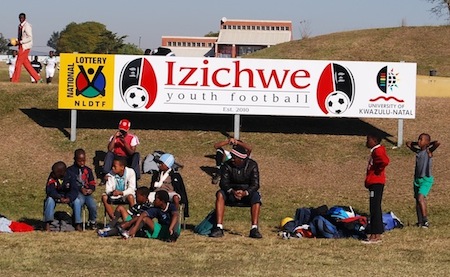
In the wake of Pitso Mosimane’s firing as Bafana Bafana head coach, there seems to be general agreement in South African football circles that a plan is needed to develop the local game constructively and sustainably.
On this blog, Mohlomi Maubane recently argued in favor of a German model that synchronizes the interests of the FA, the national team, and of professional clubs. “It is by virtue of young players being trained well that the German national team, and any other national team, can realise its full potential,” added Ted Dumitru and Sipho “King K” Kekana over at maximalfootball.com. “Lack of technical education in this vital aspect made many nations, including SA, compete without an identity and the results have been disastrous,” the two experts point out.
On June 9-10, 2012, the national finals of the under 15 boys’ Manchester United Premier Cup provided some clues about what lies ahead for South African football. At the Nike Football Training Centre in Klipspruit, Soweto, Ajax defeated SuperSport United in the final (2-1) to qualify for the global finals in China in July. The rest of the field featured Orlando Pirates, Izichwe FC, Bidvest Wits, School of Excellence, Diambars, and Mamelodi Sundowns.
According to observers’ accounts, most teams at the Premier Cup fielded sides of tall, strong boys indulging in well-rehearsed kick-and-rush football. Two exceptions stood out: Izichwe FC and School of Excellence. The case of Izichwe, an extraordinary program based at the University of KwaZulu-Natal in Pietermaritzburg, illustrates how making highly technical footballers out of promising teenagers requires not only financial resources and qualified coaches, but also time and patience.
Izichwe distinguishes itself in a number of ways from the vast majority of youth programs in South Africa and elsewhere on the continent. Founded in 2010, when my family had the privilege of being welcomed into the Izichwe clan, the academy got its name from the regiment (ibutho) of Shaka kaSenzangakhona, the founder of the Zulu kingdom. It operates on a shoestring budget compared to the PSL youth teams in the Premier Cup. It is a not-for-profit organization in which the parents and sponsors — both local and international — actively participate in shaping the sporting and educational development of each youngster.
After intense daily training sessions, the Izichwe boys, many of whom come from humble backgrounds, remain on the University of KwaZulu-Natal campus for a meal and to complete their homework before returning home for the night. Developing responsible citizens is considered just as important as training future members of Bafana Bafana. From a football standpoint, Thabo Dladla, Izichwe’s technical director, points out that while Izichwe coaches understand the importance of the team their priority is individual development. The coaching staff works assiduously to develop the technical, tactical, psychological, physical and emotional aspects of the boys’ game. Another important aspect of the Izichwe approach is the lack of an overbearing, ambitious owner, the kind of person who regularly exerts pressure on coaches and players to deliver trophies and obey the dictatorship of results.
For Bafana Bafana to improve, the quality of play in the Premier Soccer League — the richest league in Africa — must improve; but this cannot happen if football development programs fail to provide players under the age of 16 with the multiple skills required for successful professional careers. Izichwe shows the way forward. As we say in isiZulu: “Phambili!”.